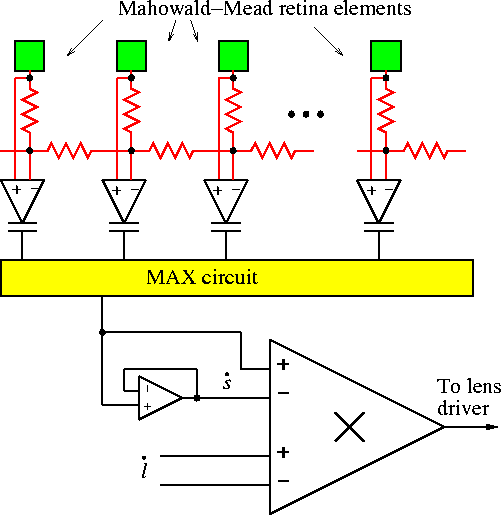The focusing chip designed by Delbrück [Delbrück 89] is
inspired by the accommodation capability of human visual system and
focuses an image onto itself by controlling its distance from the
lens. Delbrück briefly describes some of the interesting features of
accommodation capabilities of human eye, and explains the fact that
accommodation can only be done when the image or eye are moving. In
the algorithm used by Delbrück measures of sharpness, s, and the
accommodation state, l, are combined together using the tanh
function of a Gilbert multiplier to obtain the force component
![]() . This feedback force is then used in the
dynamical equation of the lens control systems. The accommodation
state, l, is derived from the lens velocity. The computation of the
sharpness, s, is the primary job of the chip.
. This feedback force is then used in the
dynamical equation of the lens control systems. The accommodation
state, l, is derived from the lens velocity. The computation of the
sharpness, s, is the primary job of the chip.
The schematic diagram of the chip is shown in Figure 3.7. The front end is the same as Mahowald-Mead's retina circuitry. The circuit computes the difference between the signal of a photodetector and the smoothed signal. When the image is originally out of focus an edge will be less different from its spatially smoothed version. When the image is focused onto the chip the difference will have its maximum value. In order to get the best results it is better to look at locations where the difference for a specific image, whether focused or out of focus, is already maximum. Intuitively, sharpness can be determined more easily on edges. The MAX circuit in fact finds the maximum difference between the input and the smoothed input. The MAX circuit is a simple variant of WTA (Winner-Take-All) circuits.
In the chip 40 retina cells have been fabricated in a 2 ![]() m CMOS
process. Each pixel is 165
m CMOS
process. Each pixel is 165 ![]() wide.
wide.

Figure 3.7: Schematic of Delbrück's focusing chip.